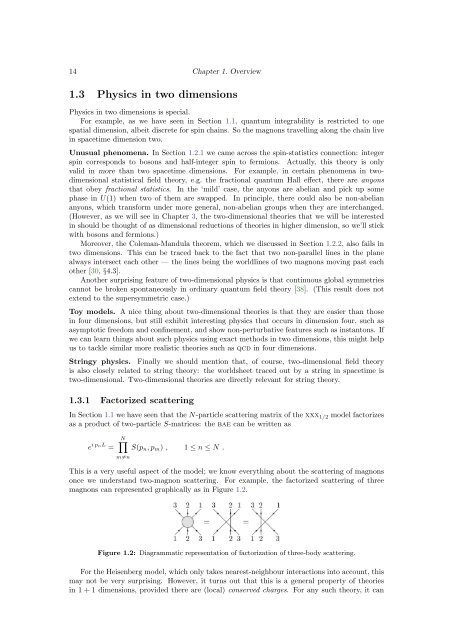The Bethe/Gauge Correspondence
The Bethe/Gauge Correspondence
The Bethe/Gauge Correspondence
You also want an ePaper? Increase the reach of your titles
YUMPU automatically turns print PDFs into web optimized ePapers that Google loves.
14 Chapter 1. Overview1.3 Physics in two dimensionsPhysics in two dimensions is special.For example, as we have seen in Section 1.1, quantum integrability is restricted to onespatial dimension, albeit discrete for spin chains. So the magnons travelling along the chain livein spacetime dimension two.Unusual phenomena. In Section 1.2.1 we came across the spin-statistics connection: integerspin corresponds to bosons and half-integer spin to fermions. Actually, this theory is onlyvalid in more than two spacetime dimensions. For example, in certain phenomena in twodimensionalstatistical field theory, e.g. the fractional quantum Hall effect, there are anyonsthat obey fractional statistics. In the ‘mild’ case, the anyons are abelian and pick up somephase in U(1) when two of them are swapped. In principle, there could also be non-abeliananyons, which transform under more general, non-abelian groups when they are interchanged.(However, as we will see in Chapter 3, the two-dimensional theories that we will be interestedin should be thought of as dimensional reductions of theories in higher dimension, so we’ll stickwith bosons and fermions.)Moreover, the Coleman-Mandula theorem, which we discussed in Section 1.2.2, also fails intwo dimensions. This can be traced back to the fact that two non-parallel lines in the planealways intersect each other — the lines being the worldlines of two magnons moving past eachother [30, §4.3].Another surprising feature of two-dimensional physics is that continuous global symmetriescannot be broken spontaneously in ordinary quantum field theory [38]. (This result does notextend to the supersymmetric case.)Toy models. A nice thing about two-dimensional theories is that they are easier than thosein four dimensions, but still exhibit interesting physics that occurs in dimension four, such asasymptotic freedom and confinement, and show non-perturbative features such as instantons. Ifwe can learn things about such physics using exact methods in two dimensions, this might helpus to tackle similar more realistic theories such as qcd in four dimensions.Stringy physics. Finally we should mention that, of course, two-dimensional field theoryis also closely related to string theory: the worldsheet traced out by a string in spacetime istwo-dimensional. Two-dimensional theories are directly relevant for string theory.1.3.1 Factorized scatteringIn Section 1.1 we have seen that the N-particle scattering matrix of the xxx 1/2 model factorizesas a product of two-particle S-matrices: the bae can be written ase i pnL =N∏S(p n , p m ) , 1 ≤ n ≤ N .m≠nThis is a very useful aspect of the model; we know everything about the scattering of magnonsonce we understand two-magnon scattering. For example, the factorized scattering of threemagnons can represented graphically as in Figure 1.2.Figure 1.2: Diagrammatic representation of factorization of three-body scattering.For the Heisenberg model, which only takes nearest-neighbour interactions into account, thismay not be very surprising. However, it turns out that this is a general property of theoriesin 1 + 1 dimensions, provided there are (local) conserved charges. For any such theory, it can
















